The oldest canals in Amsterdam - Red Light District
This part of the city has a dualistic nature which contains both hedonism and beautiful history. It is crossed by the oldest and most beautiful canals in the city.
Early use of river Amstel waters
In the twelfth century the local fishermen built a dam on the river Amstel. They named the settlement around it Amstelredamme, which means "dam in the river Amstel". The oldest known official record of that name dates to 1275 therefore it is seen as the founding date of Amsterdam.
Amsterdam canals history
The first canals were dug as defence moats around the settlements on both sides of the river. As the city grew, new defence canals were dug in wider circles. In the golden age canals saw heavy use for goods transportation which helped a lot with city commerce. And these days they are mainly a curiosity and a tourist attraction.
The Red Light District canals
Below you will find a map of the area. The numbers refer to the highlighted points of interest along the route.
Have a look at our Amsterdam canal cruise page for live canal boat cruises.
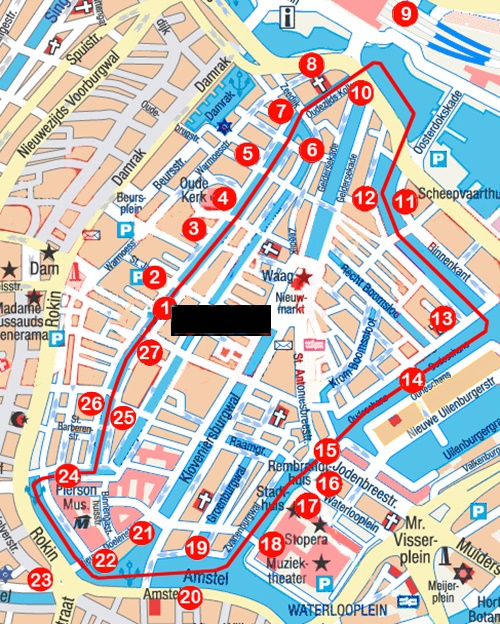
2. Red light district
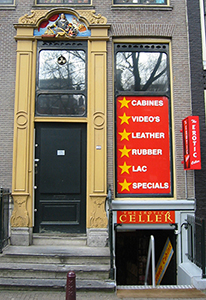 Amsterdam is the only historic city in the world, where the medieval centre is not a museum area. Here, it is a red-light district. The first Hanseatic harbour was here in the Middle Ages, which was also a centre for social activities. The first saloons and brothels appeared here in the 15th century. After the reformation, the puritan protestants tried hard to clean up this ‘Catholic ‘marsh of sins’. But the term ‘Red light district’ dates from the protestant 17th century. Work on the ships that brought all the wealth to the city was dangerous. Only one third of the sailors on the ships to the Far East came back alive from their voyages. The city was full of widows. The official mourning period for these widows was one year. After that year was over, they could show that they were ‘free’ again by putting a red lantern in their window. This is one of three versions of the origin of the term ‘Red Light District’ The picture on the left is a good illustration of the dualistic nature of this area. The sculpture above the door shows, that Maarten Harpertsz Tromp lived here. He was one of the greatest sea heroes of 17th century Holland. Today, a sex business is established on these premises...
Amsterdam is the only historic city in the world, where the medieval centre is not a museum area. Here, it is a red-light district. The first Hanseatic harbour was here in the Middle Ages, which was also a centre for social activities. The first saloons and brothels appeared here in the 15th century. After the reformation, the puritan protestants tried hard to clean up this ‘Catholic ‘marsh of sins’. But the term ‘Red light district’ dates from the protestant 17th century. Work on the ships that brought all the wealth to the city was dangerous. Only one third of the sailors on the ships to the Far East came back alive from their voyages. The city was full of widows. The official mourning period for these widows was one year. After that year was over, they could show that they were ‘free’ again by putting a red lantern in their window. This is one of three versions of the origin of the term ‘Red Light District’ The picture on the left is a good illustration of the dualistic nature of this area. The sculpture above the door shows, that Maarten Harpertsz Tromp lived here. He was one of the greatest sea heroes of 17th century Holland. Today, a sex business is established on these premises...
3. Bulldog, the oldest coffee shop in Amsterdam
 The word ‘coffee shop’ acquired its local double meaning in this place. In 1975, the stairway between the regular coffee shop on the ground floor and the concealed ‘speakeasy’ for soft drugs in the basement was opened for the public.
The word ‘coffee shop’ acquired its local double meaning in this place. In 1975, the stairway between the regular coffee shop on the ground floor and the concealed ‘speakeasy’ for soft drugs in the basement was opened for the public.
After a few police raids, they were ‘tolerated’ by the city in an effort to separate the trading streams of soft and hard drugs. It was not the first open trading place for drugs, but it is the oldest surviving one. Today we have 220 ‘coffee shops’ for soft drugs in the city and the policy has had some success. Even though Amsterdam is internationally known as ‘drugs capital’, the local hard drug problems are among the lowest in any Western European city.
4. Amsterdam Old Church
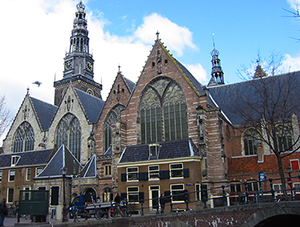 The Old Church is the oldest building in the city. construction started around 1300 and continued for more than 200 years. Its original name before the reformation was ‘St. Nicolas Church’, after the patron saint of the city and of the sailors. Today, the church serves as an exhibition centre. On the first floor, left of the main entrance, you see the only window in the church that has steel bars. Until the middle of the 19th century, the city vault was behind that window. Safely inside the church is a hidden door that leads to this storage space for municipal valuables. Around the church is a winding street with door to door ladies in red-lit windows.
The Old Church is the oldest building in the city. construction started around 1300 and continued for more than 200 years. Its original name before the reformation was ‘St. Nicolas Church’, after the patron saint of the city and of the sailors. Today, the church serves as an exhibition centre. On the first floor, left of the main entrance, you see the only window in the church that has steel bars. Until the middle of the 19th century, the city vault was behind that window. Safely inside the church is a hidden door that leads to this storage space for municipal valuables. Around the church is a winding street with door to door ladies in red-lit windows.
5. Our Dear Lord in the Attic religious museum
After the reformation, the Catholics in the city were not allowed to preach openly anymore. A rich Catholic merchant who lived only a few houses away from the Old Church, built a complete catholic church in the attic of his house. This secret second St Nicolas Church is now a museum, named “Our dear Lord in the attic”. The museum is also interesting because the interior of the merchant’s house below the church is one of the three last remaining original 17th century canal house interiors.
6. Oudezijds Kolk channels
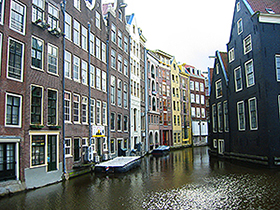 In the Middle Ages, Amsterdam looked a lot more like Venice. Most of the houses on the banks of the canals stood in the water like here on the Oudezijds Kolk. Most of the traffic was on water, transportation of goods and people was done almost exclusively by boat. Most streets on the canal sides were built much later for horse-and-carriage traffic. Today, this is one of the last three locations left in Amsterdam, where the canals have no streets alongside of them.
In the Middle Ages, Amsterdam looked a lot more like Venice. Most of the houses on the banks of the canals stood in the water like here on the Oudezijds Kolk. Most of the traffic was on water, transportation of goods and people was done almost exclusively by boat. Most streets on the canal sides were built much later for horse-and-carriage traffic. Today, this is one of the last three locations left in Amsterdam, where the canals have no streets alongside of them.
7. Harbour of Texel café
The building just before the water lock on the left is now a restaurant called “The harbor of Texel” Between the 17th and the 19th century, this was one of the most famous (or infamous) brothels in Europe.
8. St. Nicolas Church
In 1850, the Catholics regained the right to build churches with steeples for their religious services. In front, the towers of the third St. Nicolas Church can be seen, built in 1863. The sailors’ patron Saint was restored to his medieval prominence, his new church was built on the open harbour as a beacon to incoming ships. Traditionally, St. Nicolas the children’s friend arrives in front of this church every year on the 19th of November on his steamboat from Spain; to celebrate his birthday on December 5th with gifts to all the children who have been good in the past year.
9. Amsterdam Central Station
Amsterdam’s Central Station was built in 1889 on an artificial island in front of the city. The mayor and city council heavily protested against the location of the station, as it closed off the city from the sea. The national government would only contribute funds to the construction of the station if the city agreed to their choice for the location. Grudgingly, the city council agreed. This was seen as the first ever victory of the national government over the once mighty rulers of Amsterdam.
10. Weeping Tower of Amsterdam
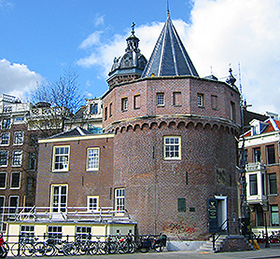 On your left is the biggest of the three remaining corner-towers of the medieval city-wall, the Schreierstoren. The story goes that in the old days, the wives of the sailors who went to sea, stood on the transom of this tower to wave their husbands goodbye. Maybe forever, they knew how many would be killed at sea by scurvy, pirates and war. But a small copper plaque on the base of the tower explains dryly that the name has nothing to do with weeping. The old Dutch word ‘skrayer’ meant: ‘corner’. The tower stood on a sharp corner of the city-wall.
On your left is the biggest of the three remaining corner-towers of the medieval city-wall, the Schreierstoren. The story goes that in the old days, the wives of the sailors who went to sea, stood on the transom of this tower to wave their husbands goodbye. Maybe forever, they knew how many would be killed at sea by scurvy, pirates and war. But a small copper plaque on the base of the tower explains dryly that the name has nothing to do with weeping. The old Dutch word ‘skrayer’ meant: ‘corner’. The tower stood on a sharp corner of the city-wall.
11. Shipping House / Amrath hotel
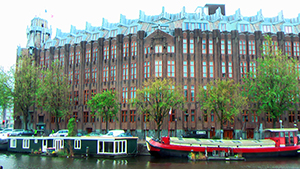 The Shipping House was built in 1902 as the head office for six big shipping companies. The building is shaped like the bow of a ship. It is richly decorated inside and out with statues, ornaments and illustrations, all related to shipping, ships and the sea. It is considered to be one of the most beautiful examples of ‘Amsterdam School’ architecture. Today, the building houses the Amrath hotel, a five star hotel.
The Shipping House was built in 1902 as the head office for six big shipping companies. The building is shaped like the bow of a ship. It is richly decorated inside and out with statues, ornaments and illustrations, all related to shipping, ships and the sea. It is considered to be one of the most beautiful examples of ‘Amsterdam School’ architecture. Today, the building houses the Amrath hotel, a five star hotel.
12. Medieval winter harbor
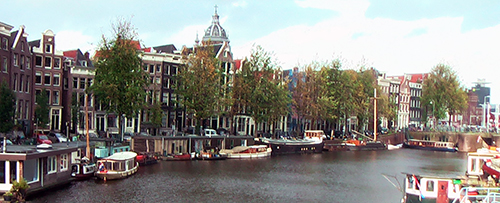 In the middle ages, this canal was on the outside of the city, facing the Southern Sea. It served as a winter harbour for the traders’ ships that sailed to the Baltic Sea. In the 17th century, the trade expansion to Africa and the Far East brought bigger ships into the harbour, which sailed summer and winter. The main harbour was moved to the present ‘Eastern Dock’, which was the open seafront in those days.
In the middle ages, this canal was on the outside of the city, facing the Southern Sea. It served as a winter harbour for the traders’ ships that sailed to the Baltic Sea. In the 17th century, the trade expansion to Africa and the Far East brought bigger ships into the harbour, which sailed summer and winter. The main harbour was moved to the present ‘Eastern Dock’, which was the open seafront in those days.
13. Montelbaans - tower
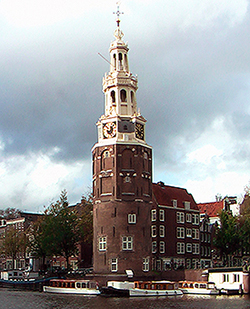 The third leftover of the medieval city wall is the ‘Montelbaans’ tower, built in 1516. The city-wall was taken down for a new expansion in 1585. The steeple with the clocks was added to the tower in 1606, after urgent requests from the neighbourhood for a public timekeeping facility. Without the support of the wall, the tower’s foundation became unstable. Four years later, it leaned over as dangerously as the famous tower of Pisa. After several failed attempts to improve the existing foundation, the tower was pulled straight with long cables. A big block was cemented on a new foundation around the base. Amsterdammers used to call this tower ‘Crazy Jack’ and they thought it was bewitched. The clocks in the steeple used to start chiming at the strangest hours. A few years ago, your reporter captain Jan had his own mysterious experience with Crazy Jack. For three weeks in August, every night light-flashes came from the steeple, as if it was a lighthouse. I asked the police, the water authority, the historic society, the city and many other institutions, but no one knew where those light flashes came from. That mystery is not solved till this day.
The third leftover of the medieval city wall is the ‘Montelbaans’ tower, built in 1516. The city-wall was taken down for a new expansion in 1585. The steeple with the clocks was added to the tower in 1606, after urgent requests from the neighbourhood for a public timekeeping facility. Without the support of the wall, the tower’s foundation became unstable. Four years later, it leaned over as dangerously as the famous tower of Pisa. After several failed attempts to improve the existing foundation, the tower was pulled straight with long cables. A big block was cemented on a new foundation around the base. Amsterdammers used to call this tower ‘Crazy Jack’ and they thought it was bewitched. The clocks in the steeple used to start chiming at the strangest hours. A few years ago, your reporter captain Jan had his own mysterious experience with Crazy Jack. For three weeks in August, every night light-flashes came from the steeple, as if it was a lighthouse. I asked the police, the water authority, the historic society, the city and many other institutions, but no one knew where those light flashes came from. That mystery is not solved till this day.
14. Oude Schans
The city-wall was on the right side of the canal until 1595. After the wall was taken down for another city expansion, rich merchants built their homes on that side. Most of them already had warehouses on the other side of the canal. It was still customary to live close to one’s merchandise. In 1830, a prankster created appearances of ‘dancing ghosts’ on this canal. For weeks, the Amsterdammers were mesmerized by these appearances. Every night, big crowds appeared here at the canal side, hoping to see the sprits. They were said to appear on the corner across the canal from the Montelbaans-tower. For most of the 19th century, this corner was known as the ‘dancing spirits-corner’
15. Rembrandt House Museum
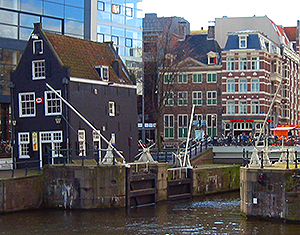 The second house from the corner on the left, next to the St. Anthony’s lock, is the Rembrandt House Museum, where the painter lived from 1639 until he was declared bankrupt in 1658..Today’s Rembrandt museum displays almost all 250 etchings of the master. In 1999, the interior was restored to its 17th century origins, showing Rembrandt’s own living environment.
The second house from the corner on the left, next to the St. Anthony’s lock, is the Rembrandt House Museum, where the painter lived from 1639 until he was declared bankrupt in 1658..Today’s Rembrandt museum displays almost all 250 etchings of the master. In 1999, the interior was restored to its 17th century origins, showing Rembrandt’s own living environment.
16. St. Anthony’s lock
This water lock was built in 1602 to replace a dam between two former defence moats on the eastern side of the city. Rembrandt made a drawing of the lock in 1648, his house was across the street from the lock. The lock-guard’s house was built in 1695. Today, it is one of the most ‘leaning’ houses in the city. It was restored recently and opened as café ‘The Lock guard’.
17. Amsterdam Waterloo Square Flea market
The Jewish immigrants in the 17th century were excluded from work in the traditional trades like carpenter, mason, baker etc., which were protected by guilds or trade unions. Buying and selling goods was one of the few sources of income open to them. A big open-air market developed in the middle of their neighbourhood, which survives to this day. The Waterloo Square flea market is more than 300 years old. It almost disappeared at the end of the 20th century, because the new City Hall was built on most of its territory.
18. Amsterdam City Hall
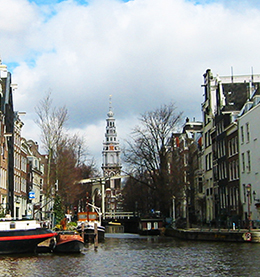 We call this building the ‘Stopera’, a new word that was coined for our new City Hall annex Opera house. Architect Holzberger went 180 % over his budget for this combination building. It was completed in 1986, after 2 years of delay because of sabotage and demonstrations against the project. Amsterdammers have taken a long time getting used to the complex, although the opera-house is appreciated for its supreme acoustics and technical equipment.
We call this building the ‘Stopera’, a new word that was coined for our new City Hall annex Opera house. Architect Holzberger went 180 % over his budget for this combination building. It was completed in 1986, after 2 years of delay because of sabotage and demonstrations against the project. Amsterdammers have taken a long time getting used to the complex, although the opera-house is appreciated for its supreme acoustics and technical equipment.
19. Southern church of Amsterdam
In the Middle ages, the northernmost part of the Amstel river served as a defence moat, the city-wall was on the Northern side of the river. The view from the Amstel River on the medieval Groenburgwal, with in the background the steeple of the Southern Church, has been painted by a number of famous painters. Rembrandt made drawings here, but also the 19th century impressionist Monet painted this scene
20. Dancing queens houses
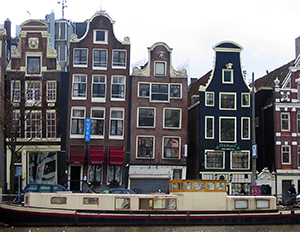 Amsterdam was built on muddy marshland. All the old houses in the city have foundations of Scandinavian pine-wood poles which were driven about 16 m. (50 ft.) through the mud, into the sandy layer below. As long as these poles are below the groundwater-level, they retain their structural strength. If the water level drops, the tops of the poles come out of the water and then they rot rapidly. On the southern side of the river, five houses in a row can be seen, which are all sagging sideways and leaning on each other. We call them ‘The dancing queens’ They show what happens when the groundwater-level gets too low.
Amsterdam was built on muddy marshland. All the old houses in the city have foundations of Scandinavian pine-wood poles which were driven about 16 m. (50 ft.) through the mud, into the sandy layer below. As long as these poles are below the groundwater-level, they retain their structural strength. If the water level drops, the tops of the poles come out of the water and then they rot rapidly. On the southern side of the river, five houses in a row can be seen, which are all sagging sideways and leaning on each other. We call them ‘The dancing queens’ They show what happens when the groundwater-level gets too low.
21. Doelen Hotel
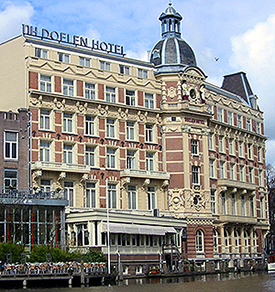 The name ‘Doelen Hotel’ on the northern bank of the river refers to the main exercise hall of the Civil Guards, which was located here since the Middle Ages. Rembrandt painted his world famous ‘Night watch’ painting in this hall. It portrays a group portrait of these Civil Guards. The canvas was too big for Rembrandt’s studio, so he made the painting ‘on location’. It was exhibited in this hall for several years, the only period in which it was seen in its full glory.
The name ‘Doelen Hotel’ on the northern bank of the river refers to the main exercise hall of the Civil Guards, which was located here since the Middle Ages. Rembrandt painted his world famous ‘Night watch’ painting in this hall. It portrays a group portrait of these Civil Guards. The canvas was too big for Rembrandt’s studio, so he made the painting ‘on location’. It was exhibited in this hall for several years, the only period in which it was seen in its full glory.
When the painting was moved to the City Hall on the Dam Square in 1715, it turned out to be too big for the wall it was going to hang on. Part of the painting was cut off and discarded. So what we see today in the Rijksmuseum, is only about 80 percent of the original Night watch’.
22. Hotel de’l Europe
One of the top hotels in the city, ‘de l’Europe’ was one of beer-brewer Alfred Heineken’s favourite watering holes. Around the corner is a small bar called ‘Freddie’s Bar’ Before he was kidnapped, Heineken himself used to sit there frequently to receive his guests. The hotel was a birthday-present from Mr. Heineken to his wife, so it’s owned by Mrs. Charlene Heineken.
Worth mentioning here is the The Heineken Experience beer brewing attraction.
23. Mint Tower
Three corner towers are the only remnants today of the medieval city wall. The slender ‘Mint Tower’ is one of them. In 1672, the national coins were minted in this tower for one year, hence its name. This is the location where the Amstel river entered the city in the middle ages. There were defence towers on both sides here, the bigger one located on the spot where Hotel de l’Europe can be seen today. There was a defence-palisade in the river, with a narrow gate for ships.
24. Grimburgwal
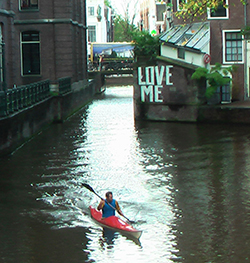 Medieval Amsterdam can be entered on the water hrough Grimburgwal, a narrow connecting canal between the Amstel river and the main canal of the Red light district, “Oudezijds Voorburgwal” In the wall on the left side of this narrow passageway, some stones from the original city wall can be seen. This defence wall was taken down in 1384 for the first city expansion. Between the two canals stands the ‘House on three canals’. In the middle ages there was a guesthouse on this spot. The present shape of the house dates from 1609.
Medieval Amsterdam can be entered on the water hrough Grimburgwal, a narrow connecting canal between the Amstel river and the main canal of the Red light district, “Oudezijds Voorburgwal” In the wall on the left side of this narrow passageway, some stones from the original city wall can be seen. This defence wall was taken down in 1384 for the first city expansion. Between the two canals stands the ‘House on three canals’. In the middle ages there was a guesthouse on this spot. The present shape of the house dates from 1609.
25. Oude Zijds Voorburgwal
 This is the oldest canal in the city. Digging this canal began in the year 1342. The name means ‘Front defence wall on the old side’.
This is the oldest canal in the city. Digging this canal began in the year 1342. The name means ‘Front defence wall on the old side’.
Before the 17th century expansion, the (Catholic) rich merchants lived here. In those days they dressed in velvet, so the canal was also called ‘The Velvet defence-canal’.
The first arched bridge marks the border with the old harbour area, which developed into the famous Red Light District.
26. University of Amsterdam
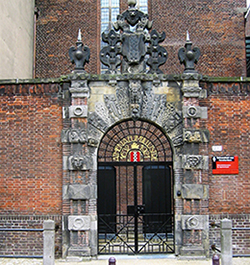 The chapel of the ‘St. Agnes’ monastery dates from 1470. The ‘Athaeneum Illustre’ was established here in 1632. Initially a bachelor-level prep-school for the ‘real universities’ of Utrecht and Leiden. In spite of local academic ambitions, 220 years passed before the school acquired university status. In 1864, the new ‘University of Amsterdam’ moved to a bigger facility and the old chapel was successively used as a school for girls, a music library, a workshop for military tailors and a welfare office. Today it is once more part of the University of Amsterdam.
The chapel of the ‘St. Agnes’ monastery dates from 1470. The ‘Athaeneum Illustre’ was established here in 1632. Initially a bachelor-level prep-school for the ‘real universities’ of Utrecht and Leiden. In spite of local academic ambitions, 220 years passed before the school acquired university status. In 1864, the new ‘University of Amsterdam’ moved to a bigger facility and the old chapel was successively used as a school for girls, a music library, a workshop for military tailors and a welfare office. Today it is once more part of the University of Amsterdam.
27. Amsterdam Municipal Pawnshop
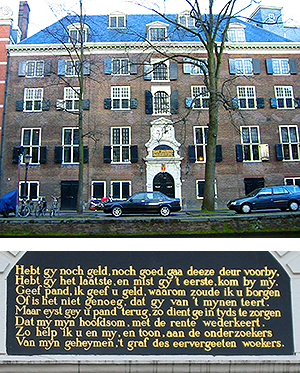 The old Pawnshop on the left side on nr. 300 was opened in the year 1616 as a municipal charity to protect poor people from loan-sharks. It is considered to be the oldest bank in Amsterdam and on e of the oldest in the world.
The old Pawnshop on the left side on nr. 300 was opened in the year 1616 as a municipal charity to protect poor people from loan-sharks. It is considered to be the oldest bank in Amsterdam and on e of the oldest in the world.
Today, this municipal lending institution operates several branch offices all over the city, which do thriving business in times of economic recession. The head office is still in this historic building. Over the entrance is a poem in old-Dutch, which translates to:
If you have neither money nor goods: so pass this door. If you have the last and miss the first, then come to me.
Give pawn, I give you cash. Why should I give security? Or is it not enough, that you profit from what’s mine? But if you demand your pawn returned, so take care that the main sum with interest comes back to me. So I help you, and show the searchers of my secret, the grave of the in the past forgotten loan sharks.
28. Hotel The Grand (Princes’ Court)
On the northern side, the Amsterdam School architecture of the former city-hall of Amsterdam can be seen, which now houses Hotel ‘The Grand’. In the courtyard of this building, you see the front gable of a complex that was founded in 1411 as a monastery. After the reformation from the Catholics, the building was renamed “Princes’ Court” and rebuilt to serve as a residence for visiting royalty. In 1581, Prince William of Orange stayed here. Other famous residents were the Earl of Leicester in 1587 and Maria de Medici in 1638.
29. Amsterdam Urinal that is certified National Monument
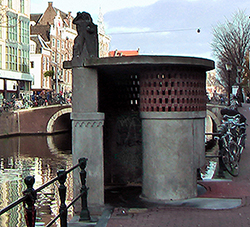 Together with a new wing of the former City hall, in 1926 a urinal was built on the canal side opposite the entrance gate. It was meant to serve the visitors to City hall, so it was designed in the same ‘Amsterdam school’ architecture as the new wing, and it was decorated with sculptures by municipal sculptor Hildo Krop. Because of these sculptures and the design of the urinal, it acquired the status of National monument. City hall moved to its present location on the Amstel in 1986. Hotel ‘The Grand’ now occupies the building.
Together with a new wing of the former City hall, in 1926 a urinal was built on the canal side opposite the entrance gate. It was meant to serve the visitors to City hall, so it was designed in the same ‘Amsterdam school’ architecture as the new wing, and it was decorated with sculptures by municipal sculptor Hildo Krop. Because of these sculptures and the design of the urinal, it acquired the status of National monument. City hall moved to its present location on the Amstel in 1986. Hotel ‘The Grand’ now occupies the building.
